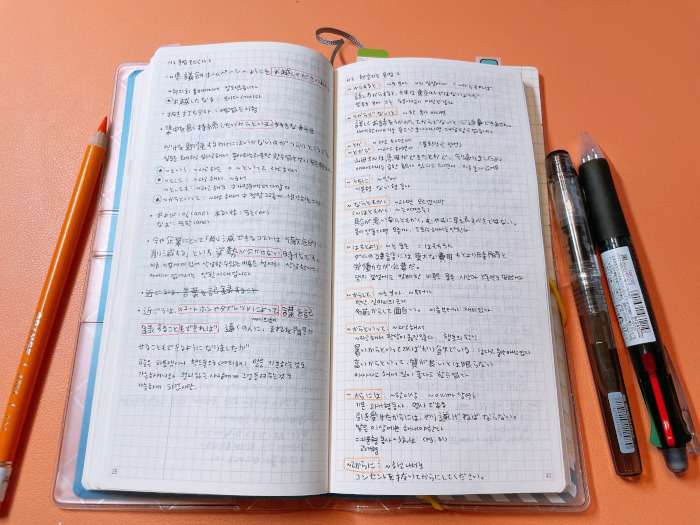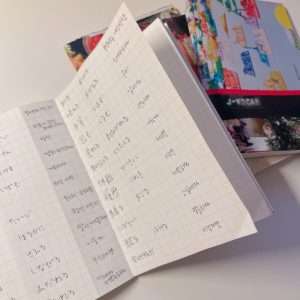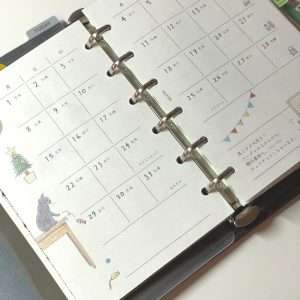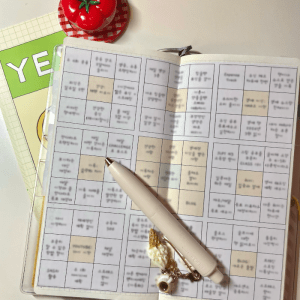Improve JLPT Grammar Score: The Power of Reviewing Mistakes
Improving your JLPT grammar score can feel daunting, especially with the complexity of the grammar section. What is the best way to improve JLPT grammar? Through my studies, I realized that one of the most effective methods was reviewing mistakes during practice exams. By focusing on the questions I got wrong, I identified patterns and corrected misunderstandings. This approach gradually helped boost my grammar score.
In this post, I’ll share my journey and the strategies that turned my mistakes into valuable learning opportunities. These techniques not only improved my JLPT grammar score but also made my study sessions more effective and rewarding.
Table of Contents
My JLPT Grammar Journey
When I began preparing for the JLPT, the grammar section felt particularly overwhelming. In my first practice exam, I scored only 12 out of 22 points, which left me feeling frustrated. I realized that if I wanted to improve my JLPT grammar score, I needed to change my study approach.
To address this, I shifted my focus to reviewing the questions I had answered incorrectly. I revisited the grammar book I was using and carefully went over the explanations for each wrong answer. Through this process, I discovered that I had been missing some key concepts and failing to grasp the nuances of certain grammar points.
Taking the time to understand why my answers were wrong allowed me to deepen my understanding of Japanese grammar. I started noting difficult grammar points and revisiting them regularly during my study sessions.
What Are Common Grammar Mistakes in JLPT Exams?
Many JLPT test-takers struggle with grammar due to subtle nuances, tricky particles, and confusing sentence structures. Here are some of the most common mistakes learners make on the exam and how to avoid them:
- Misusing Particles (は vs. が, に vs. で)
- Example Mistake: 彼は日本に行きますが、彼が東京に住んでいます。
- Correction: 彼は日本に行きますが、彼は東京に住んでいます。
- Why? は is used for contrast or general topics, while が emphasizes the subject of the sentence.
- Incorrect Verb Conjugation (Casual vs. Formal Forms)
- Example Mistake: 先生に話しましたか? (Did you talk to the teacher?)
- Correction: 先生にお話ししましたか?
- Why? 敬語 (Keigo) or polite forms are required when speaking about or to someone of higher status.
- Confusing Similar Grammar Structures (~られる vs. ~させる)
- Example Mistake: 先生が学生を読ませた。(The teacher read the student.)
- Correction: 先生が学生を読ませた。(The teacher made the student read.)
- Why? ~させる is the causative form, meaning “to make someone do something,” whereas ~られる is passive.
- Using the Wrong Conditional Form (と vs. ば vs. たら)
- Example Mistake: 雨が降ると、試験は中止になります。(If it rains, the test will be canceled.)
- Correction: 雨が降ったら、試験は中止になります。
- Why? と is for natural consequences, while たら is used for one-time events or specific situations.
- Overusing Direct Translations from English
- Example Mistake: 私は昼ごはんを食べたあとで、図書館に行きます。(After I ate lunch, I will go to the library.)
- Correction: 私は昼ごはんを食べてから、図書館に行きます。
- Why? ~たあとで implies sequential actions but is unnatural in this case. ~てから is the correct form for “after doing” something.
How to Avoid JLPT Grammar Mistakes?
Here are some tips that I found very helpful in improving my grammar skills. If you’re looking to boost your JLPT grammar score, give these strategies a try:
Use a Comprehensive Grammar Book
Choosing the right grammar book is essential for improving your JLPT grammar score. I personally looked through books at local stores and checked online reviews before settling on one that matched my needs. A well-structured book not only explains grammar rules but also provides contextual examples, practice exercises, and common usage pitfalls. Look for books that categorize grammar points based on JLPT levels, as this will help you focus on relevant material.
In addition to textbooks, I also used online resources such as Bunpro, an SRS-based JLPT grammar learning platform, and Nihongo no Mori’s grammar videos, which provide detailed explanations and examples. JLPT Sensei was another helpful site with clear explanations and practice examples. This mix of structured books and interactive tools gave me a well-rounded way to study JLPT grammar.
Take Detailed Notes
As I reviewed my mistakes, I kept a running grammar note both on paper and in Notion. I’d jot down brief explanations, example sentences, and even color-code patterns I kept getting wrong. This simple study guide helped me spot repeat issues and made review sessions more efficient.
Using Notion also allowed me to link external resources and track how often I revisited each point. Over time, this helped me build a reliable reference I could come back to anytime I needed a quick refresher.
Revisit and Practice Regularly
I made it a habit to revisit tricky grammar points each week—usually on weekends. Sometimes I rewrote sentences from past practice exams using the correct forms, and other times I used flashcards or short writing prompts. This regular check-in helped those points stick better and reduced careless errors. Try using these grammar points in journaling, conversation, or language exchanges to make them feel more natural.
Another effective method is shadowing—listening to Japanese sentences using target grammar and repeating them aloud. This helps internalize structures and improves both comprehension and speaking skills. Additionally, keeping a grammar mistake log where you track incorrect answers and write corrected versions can be useful for long-term retention.
The key is repetition and diversification of practice—by consistently practicing in varied ways, you’ll solidify your knowledge and be better prepared for the exam.
Apply Grammar in Writing and Speaking
I used to challenge myself by writing daily journal entries using specific grammar forms I had struggled with that week. It felt awkward at first, but over time, it made those expressions more natural. When I had time for language exchange, I also tried slipping them into conversation, which helped reinforce their usage in real time.
Additionally, immerse yourself in native content such as novels, articles, or podcasts that frequently use JLPT-related grammar. Take notes on how grammar points appear in context and try to replicate similar sentence structures in your own writing. Practicing grammar through diverse mediums will deepen your understanding and make it easier to recall and apply during the exam.
Be Patient and Celebrate Progress
When I first scored higher on a grammar section I’d been struggling with, I gave myself a little reward—a break with my favorite drink and podcast. Celebrating those small wins made the long process feel more manageable and helped me stay motivated.
Improving your JLPT grammar score doesn’t happen overnight—it requires steady effort over time. Keeping track of progress, such as recognizing a challenging grammar structure in a reading passage or successfully using it in conversation, helps maintain motivation and reinforces learning.
Internalizing grammar structures takes consistent practice and realistic goal-setting. Rather than expecting immediate results, focus on gradual improvement by studying daily, even in short sessions. Reviewing mistakes, applying grammar in writing and speaking, and revisiting difficult points regularly are essential for long-term success. Each small step forward, whether mastering a tricky grammar rule or answering one more question correctly, builds confidence and brings you closer to your goal. By maintaining persistence and a positive mindset, you’ll develop the resilience needed to tackle even the toughest JLPT grammar concepts.
How Does Reviewing Mistakes Help?
It Highlights Weaknesses
Many learners study grammar in a broad sense, but reviewing mistakes pinpoints the exact areas that need improvement. By analyzing wrong answers, you can see which grammar patterns or rules you consistently struggle with.
It Reinforces Learning
Revisiting mistakes ensures that you don’t forget grammar rules. The more you expose yourself to previously misunderstood concepts, the more likely they will become second nature. Consistently reviewing mistakes allows you to develop a deeper understanding of how certain grammar structures function and why certain answers are incorrect.
Moreover, re-examining past errors in various contexts—such as reading, listening, writing, and speaking—ensures that you truly internalize these grammar rules. Try explaining the mistakes to yourself or someone else, as teaching a concept often reinforces your own learning. This continuous cycle of reviewing, correcting, and applying knowledge builds a solid foundation for long-term language retention and fluency.
It Builds Test-Taking Confidence
Seeing improvement through mistake analysis provides a confidence boost. Instead of feeling lost during the test, you’ll recognize grammar patterns and apply the correct rules. Over time, Repeated exposure to mistakes makes it easier to recall concepts during high-pressure moments like the actual JLPT exam.
Additionally, as you become more familiar with common grammatical structures, you will develop a sense of intuition for choosing the right answers even for tricky questions. This growing confidence not only helps improve your test performance but also enhances your overall language proficiency, making Japanese grammar feel more natural in both writing and conversation.
How Reviewing Mistakes Improved My Score

After dedicating time to reviewing my mistakes and targeting my weaknesses, I took another practice exam. This time, I scored 18 out of 22 points in the grammar section – a significant improvement from my initial score of 12 out of 22.
This experience showed me the power of reviewing mistakes while studying for the JLPT grammar section. By identifying my weak areas and actively working on them, I was able to make meaningful progress in a relatively short period.
The Power of Reviewing Mistakes
Reviewing the answers you got wrong in the JLPT grammar section is a powerful strategy for improving your score. Rather than simply marking incorrect answers and moving on, taking the time to analyze and understand your mistakes leads to a deeper grasp of grammar concepts. This process helps you identify recurring patterns in your errors and address weak areas systematically.
One of the most effective ways to review mistakes is to rework incorrect questions by writing out correct versions and explaining why the right answer is correct. Additionally, you can keep a mistake journal where you log each grammar mistake, its explanation, and example sentences for reinforcement. Over time, this log will become a valuable reference for tracking improvement and identifying persistent problem areas.
Beyond individual study, discussing mistakes with language partners or teachers can provide alternative explanations and new perspectives that enhance understanding. Engaging in active recall by testing yourself on previously made mistakes ensures that the concepts stick long-term.
Everyone’s language learning journey is different, so don’t be discouraged by initial setbacks. Progress takes time, and consistent effort in reviewing mistakes will result in noticeable improvements. With persistence and a commitment to learning from your errors, you can achieve your goal of mastering Japanese grammar. Keep refining your study methods, and you’ll see steady progress in your JLPT grammar score.
📖 Must-Read JLPT Study Tips & Strategies
- JLPT Test Results: How I Passed JLPT N1
- What to Expect on JLPT Exam Day: My Experience & Helpful Tips
- JLPT Study Guide: Last-Minute Preparation Tips for Success
- 5 JLPT Study Tips: How to Stay Motivated and Beat Burnout
- Improve JLPT Grammar Score: The Power of Reviewing Mistakes
- How to Improve JLPT Listening: Top Strategies & Tips
- Why I Chose the JLPT: My Journey to Learning Japanese
📖 Explore More JLPT Study Tips
Looking for more ways to improve your JLPT study routine? Check out all my JLPT Study Tips for in-depth strategies, exam preparation advice, and motivation!




















